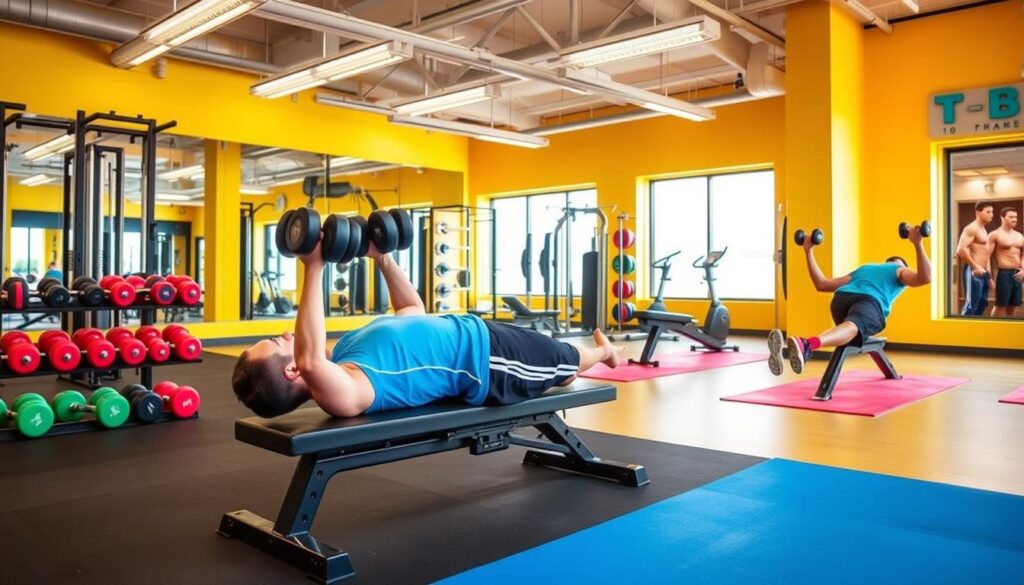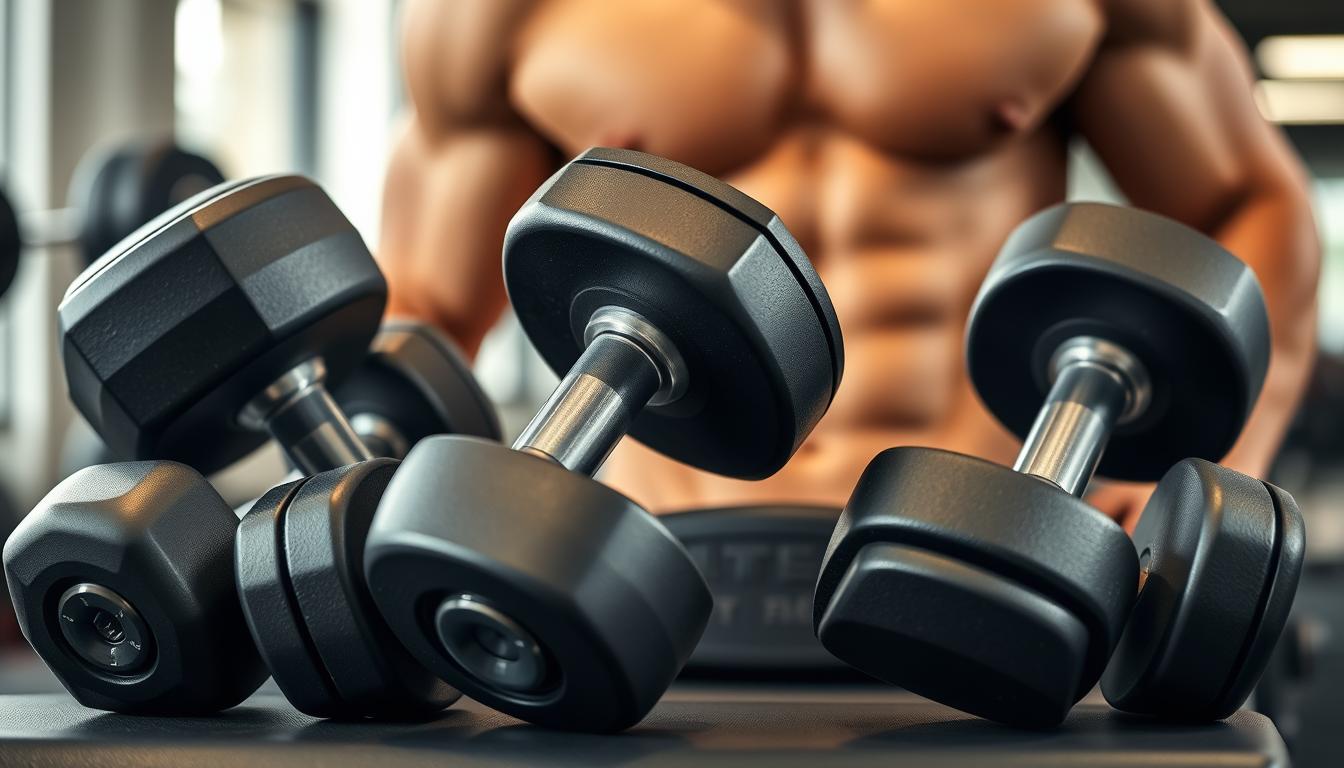In recent years, the fitness community has seen a surge in the popularity of effective dumbbell workouts, specifically geared towards targeting the lower chest area. As more individuals seek to enhance their physical appearance and strength, these lower chest exercises have become a crucial component of comprehensive strength training routines.
When executed correctly, these exercises not only sculpt and enhance your lower pectorals but also contribute to the overall development and functionality of your chest muscles. Whether you prefer working out at home or hitting the gym, incorporating dumbbell workouts into your regimen can offer versatile and practical fitness solutions tailored to your needs.
Key Takeaways
- The rise of effective dumbbell workouts tailored for the lower chest.
- Proper execution leads to improved chest enhancement and functionality.
- Works perfectly for both home and gym-based routines.
- Integral part of any well-rounded strength training plan.
- Offers practical and versatile solutions for fitness enthusiasts.
Introduction to Dumbbell Workouts
Incorporating dumbbells into your chest training routine can yield substantial rewards. By focusing on dumbbell workouts for lower chest, you can enhance both the aesthetic and functional aspects of your pectoral muscles. These workouts offer a myriad of benefits, from improved muscle coordination to increased range of motion.
The Importance of Targeting the Lower Chest
Targeting the lower chest is crucial for achieving a well-balanced and defined pectoral region. Anatomically, focusing on the lower chest helps in creating a more pronounced and aesthetically pleasing chest profile. Functionally, it contributes to stronger and more balanced upper body strength. Engaging in dumbbell workouts for lower chest also ensures that the lower pecs are not overlooked, which is often the case in many standard chest routines.
Benefits of Using Dumbbells
Using dumbbells for pectoral workouts offers distinct advantages over machines or barbells. Dumbbells allow for a greater range of motion, which is pivotal in engaging more muscle fibers and achieving deeper muscle activation. They also promote unilateral training, ensuring that both sides of the chest develop symmetrically, minimizing the risk of muscle imbalances.
- Improved Range of Motion: Dumbbells provide a wider range of motion, enabling deeper muscle stretches and contractions.
- Enhanced Muscle Coordination: Each arm works independently, improving muscle coordination and stabilization.
- Balanced Muscle Growth: Promotes symmetry and helps prevent dominant muscle groups from taking over the workout.
Understanding Lower Pectoral Training
Grasping the intricacies of lower pectoral training involves recognizing the unique characteristics of the muscle anatomy within this region. Knowing which muscles are involved and understanding their functions can significantly enhance the effectiveness of your chest workouts.
Anatomy of the Lower Chest Muscles
The lower portion of the pectoralis major, often referred to as the sternal head, plays a crucial role in lower pectoral training. This muscle originates from the sternum and attaches to the humerus, allowing for powerful movements such as pushing and pressing exercises. Incorporating exercises that target this specific muscle group helps build a well-defined and muscular lower chest.
Common Mistakes to Avoid
Engaging in effective chest workouts requires not only proper form but also an awareness of common pitfalls that can impede progress or cause injury. Some frequent mistakes include:
- Ignoring the importance of proper form, which can lead to strain or injury.
- Using weights that are too heavy, sacrificing form for the illusion of strength.
- Inconsistency in workout routines, leading to suboptimal gains.
By avoiding these errors and focusing on the correct techniques, individuals can ensure safer and more productive lower pectoral training.
| Key Aspect | Explanation |
|---|---|
| Proper Form | Essential for effective workouts and injury prevention. |
| Weight Selection | Choose weights that allow maintaining form while providing enough resistance. |
| Consistency | Maintain regular workout schedules for optimal muscle growth. |
Main Workout Routine for Lower Chest
Crafting an effective workout routine for lower chest development is essential for achieving balanced muscle growth and strength. This section outlines a comprehensive plan, starting with crucial warm-up exercises, followed by targeted primary dumbbell exercises, and ending with proper cool-down and post-workout stretching.
Warm-Up Exercises
Beginning with appropriate warm-up exercises will prepare your muscles and joints, preventing injuries and enhancing performance. Spend 5-10 minutes performing dynamic stretches like arm circles, push-ups, and light cardio activities to increase blood flow to the chest area.
Primary Dumbbell Exercises
The main component of your lower chest workout routine should include focused and efficient dumbbell exercises. Here are some top choices:
- Decline Dumbbell Bench Press: This exercise effectively targets the lower chest muscles. Make sure to control the weights and maintain proper form.
- Dumbbell Chest Flyes: Adjust the bench to a slight decline to engage the lower pectorals more thoroughly.
- Dumbbell Pullover: This exercise not only works your chest but also engages the lats, offering a comprehensive upper body workout.
For detailed guidance on setting up and executing these exercises with proper form, check out this resource.
Cool-Down and Stretching
A complete workout routine is not finished without a cool-down and post-workout stretching. This helps in muscle recovery and maintains flexibility. Engage in static stretches focusing on the chest, such as the chest doorway stretch or lying chest stretch. Hold each stretch for at least 30 seconds, ensuring deep breathing to further relax the muscles.
Wrapping up your workout with these post-workout stretching techniques will provide immense benefits, aiding in overall muscle recovery and avoiding stiffness. Remember, consistency in your workout routine, along with proper form and stretching, will lead to significant lower chest development over time.
Dumbbell Chest Press for Lower Chest
The dumbbell chest press is a core exercise for those aiming for effective lower chest activation. Ensuring proper form not only maximizes results but prevents injuries. Begin by lying flat on a bench with a dumbbell in each hand. Keep your feet flat on the floor and your core engaged. Begin with your arms extended directly above your chest.

The movement involves lowering the weights slowly to your chest level and pressing them back up with controlled power. Prioritize strength exercises by maintaining a moderate weight that allows you to complete 3 sets of 10-12 reps. For beginners, I recommend starting with lighter weights to master the form, whereas seasoned lifters can consider gradually increasing the weight to challenge the muscles further.
Grip techniques significantly affect lower chest activation. A slight inward angle of your wrists causes greater emphasis on the lower pectoral muscles. Elbow placement is equally crucial; keep them at a 45-degree angle to your body to target the lower chest more effectively.
For a comprehensive approach, here are guidelines based on fitness level:
| Level | Weight Guidelines | Sets & Reps |
|---|---|---|
| Beginner | 10-15 lbs | 3 sets of 10 reps |
| Intermediate | 20-35 lbs | 3 sets of 12 reps |
| Advanced | 40-60 lbs | 3 sets of 15 reps |
Incorporating the dumbbell chest press into your routine can foster significant improvements in lower chest activation and overall pectoral strength. As part of a holistic lower chest workout, it stands as a fundamental exercise for both beginners and advanced fitness enthusiasts.
Perfecting the Decline Dumbbell Bench Press
Achieving mastery over the decline dumbbell bench press requires careful attention to detail and a focus on the proper form. This exercise is instrumental in targeting the lower pectoral muscles effectively. Here’s a comprehensive guide to ensure you’re performing this chest press technique correctly and avoiding common mistakes.
Step-By-Step Guide to Form
To execute the decline dumbbell bench press with precision, follow these steps:
- Setup: Adjust the bench to a decline angle of 15-30 degrees. Position yourself with your head lower than your feet, ensuring your back is firmly against the bench.
- Grip: Hold the dumbbells with a neutral grip. Your palms should face each other at the start of the movement.
- Execution: Lower the dumbbells slowly to your chest while maintaining control. Ensure your elbows are at a 45-degree angle to your body to maximize muscle engagement.
- Press: Push the dumbbells upwards until your arms are fully extended but not locked. Remember to exhale during this part of the movement.
- Repeat: Perform the desired number of repetitions while maintaining focus on the proper form.
Common Errors and Adjustments
Even seasoned lifters sometimes falter in their technique. Here are typical mistakes and how to rectify them:
- Improper Back Position: A common mistake is arching the back excessively. To correct this, keep your back flat against the bench throughout the exercise, which helps in maintaining the proper form.
- Incorrect Elbow Placement: Flared elbows can lead to shoulder strain. Fix this by keeping your elbows at a 45-degree angle to your torso, which ensures optimal chest engagement and reduces injury risk.
- Fast Movements: Rapid lowering and pressing can compromise control and effectiveness. To address this, focus on a slow and controlled descent, followed by a powerful, but equally controlled, press.
- Inaccurate Dumbbell Path: Bringing the dumbbells too close or too far can impact muscle targeting. Ensure that the dumbbells move in a straight line up and down, directly above your lower chest, to maintain the correct chest press technique.
By adhering to these guidelines and making required adjustments, you can perfect your decline dumbbell bench press and enhance your chest training routine effectively.
Variations of Dumbbell Chest Flyes
When it comes to refining the lower chest, incorporating different dumbbell chest flyes variations can be particularly effective. Understanding how each variation, such as incline flyes and decline flyes, impacts the chest can lead to a more sculpted physique. Let’s dive into these variations and how adjusting angles can maximize results.
Incline vs Decline Flyes
Incline flyes are performed on a bench set at a 30 to 45-degree angle. This exercise targets the upper portion of the chest, enhancing muscle definition and upper chest growth. In contrast, decline flyes use a bench at a negative angle, emphasizing the lower chest muscles and providing balanced development across the entire pectoral region.
- Incline Flyes: Focus on the upper chest
- Decline Flyes: Emphasize the lower chest
Adjusting Angles for Maximum Effect
Adjusting the bench angle can significantly alter the targeted muscle group. For example, a slight incline targets the upper chest without overburdening the shoulders, while a more pronounced decline targets the lower chest effectively. Here are some tips for optimizing your workout variations:
- Start with moderate angles: Begin with a slight incline or decline to gauge your comfort and effectiveness.
- Control the weights: Managing the weight and maintaining controlled movements are crucial for muscle growth.
- Focus on form: Proper form ensures targeted muscle engagement and reduces the risk of injury.
| Dumbbell Chest Flyes Variation | Targeted Muscle Group |
|---|---|
| Incline Flyes | Upper Chest |
| Decline Flyes | Lower Chest |
| Flat Bench Flyes | Entire Pectoral Region |
Incorporating Dumbbell Pullovers
Integrating dumbbell pullovers into your lower chest workout routine can yield significant benefits, particularly in terms of chest expansion and engagement of the serratus anterior. This exercise not only targets the pectoral muscles but also enhances the flexibility and strength of the thoracic region.
To execute a proper dumbbell pullover, begin by lying on a bench with your shoulders supported and your feet firmly planted on the ground. Hold a dumbbell with both hands, extending it above your chest. Lower the weight slowly behind your head while maintaining a full range of motion. Feel the stretch across your pectorals and then contract them to bring the dumbbell back to the starting position. This controlled movement is crucial for maximizing the benefits and ensuring safety.
Common errors when performing dumbbell pullovers include overextending the arms, arching the back excessively, and using too much weight. To minimize risks, focus on maintaining a neutral spine and choose a manageable weight. Concentrate on the stretch and contraction phases of the exercise to ensure effective chest expansion and overall muscle development.
Alternatives to Pec Deck Machine
Looking for effective pec deck alternatives to enhance your chest workout routine? You’ve come to the right place. Incorporating a variety of exercises can help target different parts of your chest muscles, providing a comprehensive and balanced approach to muscle development. Let’s dive into home workout variations and gym-based alternatives that can elevate your fitness regimen.

Home Workout Variations
For those preferring home chest workouts, several exercises can effectively replicate the benefits of a pec deck machine. Here are some of the best options:
- Dumbbell Fly: This exercise helps in isolating the chest muscles and increasing flexibility.
- Wide Push-Ups: By increasing hand width, more emphasis is placed on the pectoral muscles.
- Band Fly: Using resistance bands, this exercise offers a portable yet effective alternative.
Each of these exercises ensures you have a well-rounded chest development plan at home. You can find more detailed descriptions of these exercises here.
Gym-Based Alternatives
For those with access to gym facilities, several gym exercise variations can serve as excellent substitutes for the pec deck machine:
- Cable Crossover: This helps engage the entire chest muscle through a full range of motion.
- Incline Dumbbell Fly: Targets the upper pectoral muscles, enhancing muscle symmetry.
- Cable Decline Bench Press: Focuses on the lower pectoral muscles for balanced chest strength.
These alternatives offer dynamic resistance and comprehensive muscle activation, similar to a pec deck machine. More insights on cable exercises for arms and their advantages can be found here.
Advanced Lower Chest Sculpting Routines
For those aiming to elevate their fitness regimen, incorporating advanced routines is essential to achieve optimal chest sculpting and muscle definition. One approach involves integrating techniques like drop sets, supersets, and pyramid sets, which are designed to push the lower chest muscles beyond their usual limits, promoting hypertrophy and enhancing definition.
To start, integrating drop sets can be particularly effective. This involves performing an exercise until failure, then reducing the weight and continuing for additional reps. Such an approach keeps the muscles under tension for longer periods, fostering growth and definition.
Meanwhile, supersets encompass pairing two exercises back-to-back with no rest in between. For the lower chest, a superset might include the Dip Plus combined with a Standing Cable LC Press. This method not only increases the workout’s intensity but also aids in sculpting finely-tuned muscle definition.
Another effective technique is the pyramid set. Beginning with lighter weights and higher reps, progressing to heavier weights with fewer reps, then reverting to lighter weights again maximizes both endurance and strength. This technique can significantly enhance the lower chest muscles’ appearance.
Lastly, it is crucial to progressively increase both the intensity and volume of these advanced routines. Incorporate more sets, increase the weight, or even shorten rest periods to continually challenge the muscles and overcome any strength plateaus. For more comprehensive guidance and specific exercises like the Standing Cable LC Press, make sure your routines align with expert-recommended practices.
| Technique | Description | Benefits |
|---|---|---|
| Drop Sets | Perform an exercise until failure, reduce the weight, and continue. | Extended muscle tension, hypertrophy |
| Supersets | Pair two exercises without a rest period. | Increased intensity, better muscle definition |
| Pyramid Sets | Start light, increase weight with each set, then reduce again. | Endurance and strength gains |
Creating a Balanced Chest Workout Plan
To effectively sculpt the lower chest, it is essential to design a balanced workout plan that targets all aspects of muscle development. A holistic approach intertwining compound and isolation exercises can optimize growth and strength gains. Including both in your regimen allows each muscle group to be worked thoroughly while ensuring comprehensive development.
Mixing Compound and Isolation Exercises
Compound exercises, such as the dumbbell chest press and dumbbell pullovers, engage multiple muscle groups, delivering an efficient strength workout. These movements are crucial as they allow you to lift heavier weights and improve overall muscle coordination. On the other hand, isolation movements like dumbbell flyes focus on specific muscle groups, targeting and defining areas that compound exercises might miss. By combining these types of exercises, you can achieve a balanced workout plan that ensures all muscles are equally trained.
Weekly Schedule for Optimal Growth
Creating a weekly training schedule is imperative for optimal growth. I recommend a routine that incorporates chest workouts two to three times per week, ensuring there are adequate rest and recovery phases. An example schedule might look like this:
Monday: Compound exercises (Dumbbell Bench Press, Dumbbell Pullovers)
Wednesday: Isolation movements (Dumbbell Flyes, Decline Dumbbell Flyes)
Friday: Mixed routine (Combination of compound and isolation exercises)
Keep in mind the importance of rotating exercises and adjusting intensity to avoid plateaus. Progression is key; gradually increase the weights and vary the angle of movements to continuously challenge your muscles. This balanced workout plan will not only promote muscle growth but will also keep training engaging and effective.
FAQ
Why is targeting the lower chest important in my workouts?
Targeting the lower chest is crucial for creating a well-balanced and aesthetically pleasing chest. It enhances the overall development and functionality of your pecs, improving strength and physique.
What benefits do dumbbell workouts offer for lower chest exercises?
Dumbbells provide an improved range of motion and balanced muscle growth. They facilitate unilateral training, promoting better symmetry and coordination in your chest muscles.
What are the common mistakes to avoid during lower pectoral training?
Common mistakes include improper form, lifting too much weight too soon, and not incorporating enough variety in your exercises. Proper technique and weight selection are critical for effective and safe workouts.
How should I structure a workout routine for my lower chest?
Start with a proper warm-up, followed by primary dumbbell exercises like dumbbell chest press and decline dumbbell bench press, then conclude with cool-down and stretching exercises to aid recovery.
What are the key points for executing a dumbbell chest press targeting the lower chest?
Focus on grip techniques and elbow placement to ensure lower chest activation. Adjust your set, rep range, and weights based on your experience level for optimal results.
How can I perfect my form on the decline dumbbell bench press?
It’s essential to maintain proper form by ensuring a stable setup and controlled execution. Avoid common errors like improper hand positioning and movement trajectory to maximize muscle engagement and prevent injury.
What are the different variations of dumbbell chest flyes?
Incline and decline flyes are excellent variations. Adjusting the bench angle allows you to target different areas of the chest, enhancing overall muscle development and definition.
How do I incorporate dumbbell pullovers into my lower chest workout?
Dumbbell pullovers can help expand the chest and work the serratus anterior. Proper technique is crucial, focusing on the stretch and contraction for maximum benefit and avoiding common form errors.
What are some effective alternatives to the pec deck machine for home workouts?
Home alternatives include various dumbbell exercises that simulate the pec deck machine’s functions. For gym-goers, there are equipment-based alternatives that offer similar muscle engagement.
What advanced routines can I follow to sculpt my lower chest?
Advanced routines include techniques like drop sets, supersets, and pyramid sets. These methods challenge the muscles, promote hypertrophy, and enhance muscle definition, helping you push past plateaus safely.
How can I create a balanced chest workout plan?
Mix compound and isolation exercises for a holistic approach. Plan a weekly schedule with adequate rest and recovery, rotate exercises regularly, and adjust intensity to progress effectively over time.






